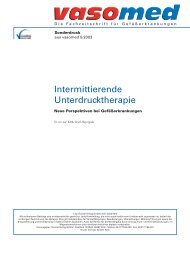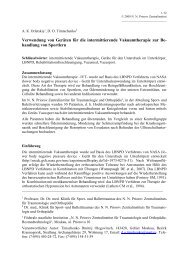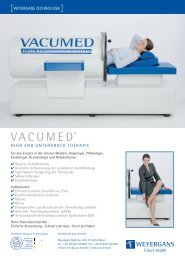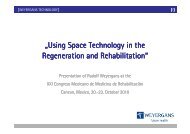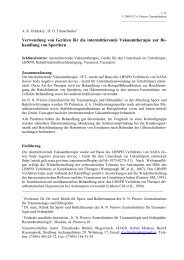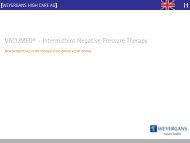Intermittent vacuum, lower body negative pressure ... - vacumed
Intermittent vacuum, lower body negative pressure ... - vacumed
Intermittent vacuum, lower body negative pressure ... - vacumed
- No tags were found...
You also want an ePaper? Increase the reach of your titles
YUMPU automatically turns print PDFs into web optimized ePapers that Google loves.
ody. Although depending on age and condition, differences are observed in terms of theresponse to sub-maximum orthostatic stress; these differences are not correlated to thetolerance differences (Hernandez JP et al., 2005).Tolerance to intermittent <strong>vacuum</strong> therapy increases after repeated treatments, which isachieved by increased ability to contract of the heart ventricle, <strong>lower</strong>ed resilience of theperipheral vessels, adjustment of the reflex mechanism to hypotension correction and increasedblood <strong>pressure</strong> (Yang CB et al., 2000).The majority of the examinations of physiological effects of intermittent <strong>vacuum</strong> therapy isbased on reactions to stable <strong>negative</strong> <strong>pressure</strong> in the <strong>lower</strong> <strong>body</strong>. When adjusting the <strong>negative</strong><strong>pressure</strong> in the <strong>lower</strong> <strong>body</strong> and returning to normal <strong>pressure</strong>, transition effects can be observed,such as <strong>lower</strong>ing of the mean blood <strong>pressure</strong> when <strong>negative</strong> <strong>pressure</strong> is applied (Hisdal J et al.,2002).When a <strong>negative</strong> <strong>pressure</strong> of -20 mmHg is quickly reached and the return to normal <strong>pressure</strong>also happens quickly, change of pulse, mean blood <strong>pressure</strong> and heart beat volume areobserved. The response of the cardio-vascular system is asymmetrical, especially with regard tothe heart beat volume. When applying <strong>negative</strong> <strong>pressure</strong>, the heart beat volume decreasesslowly within 50 sec; return to normal <strong>pressure</strong> causes a fast return of the heart beat volume tothe original level within less than 10 sec. The neutral response causing the overall vesselresistance is not sufficient to compensate for a fast change of the <strong>negative</strong> <strong>pressure</strong> in the <strong>lower</strong><strong>body</strong>. The change of the mean blood <strong>pressure</strong> is caused by the fact that apart from low<strong>pressure</strong> baro-receptors also arterial baro-receptors are activated, which react to the meanblood <strong>pressure</strong> in the event of fast reaching and discarding of low <strong>negative</strong> <strong>pressure</strong> in the <strong>lower</strong><strong>body</strong> (Hisdal J et al., 2001).Changes of the haemo-dynamic values to the level of the macro-organism have to beaccompanied with perfusion changes on tissue level. In this regard, NASA and DLR (GermanCentre for Aviation and Space Travel) have stated that application of treatment devices forintermittent <strong>vacuum</strong> therapy (Vacuumed and Vacusport by Weyergans High Care AG) causesdrastic capillary dilatation and capillarization with simultaneous increase of the micro- andmacro-perfusion in the <strong>lower</strong> extremities (Lathers CM et al., 1994).Such devices are called “external heart for the <strong>lower</strong> <strong>body</strong>”. Unlike the devices used in spacemedicine, Vacustyler, Vacumed and Vacusport operate with intermittent <strong>negative</strong> <strong>pressure</strong> anddefined intervals. The alteration of <strong>negative</strong> and normal <strong>pressure</strong> increases capillarization andcapillary dilatation and increases the flow of oxygenized blood in the <strong>lower</strong> extremities. Duringthe phase of normal <strong>pressure</strong>, venous blood and lymph move into the larger vessels (increasedbackflow). The accelerated micro-perfusion and lymphatic drainage result in a pH increase. Thiscan be used to strengthen the connective tissue (increase collagen synthesis) and for cellulitetreatment which is related to disrupted lymphatic drainage according to current scientificopinion. Since different treatment methods promote different reflexes during intermittent <strong>vacuum</strong>therapy that can be used to trigger various specific responses (Goswami N et al., 2008), anextension of the <strong>negative</strong> <strong>pressure</strong> phases is used to stimulate arterial perfusion; an extensionof the normal <strong>pressure</strong> stages is used to increase backflow of venous blood and lymph(http://www.vtstyler.co.uk/Vacustyler2.htm).Effects in Case of PathologySimilar to the use for astronauts after space travel, devices for intermittent <strong>vacuum</strong> therapyhave been successfully used against orthostatic instability of bed-ridden patients (Lathers CM etal., 1993).Angiological examinations with patients suffering from chronic arterial diseases have proven animprovement of the pulse wave in the toes and an increase of the oxygen particle <strong>pressure</strong>measured through the skin after intermittent <strong>negative</strong> <strong>pressure</strong> therapy (Straminski et al., 2001;Strauss, 2001).The effectiveness of treatment with Vacumed was examined on patients suffering from arterialobstruction stage 3 and 4 according to Fontaine. The effectiveness of the treatment wasevaluated by means of measuring the pulse wave in the toes with LLR Periquant 815 (Gutman)and oxygen <strong>pressure</strong> measurement through the skin (Radiometer GmbH). The therapy included



